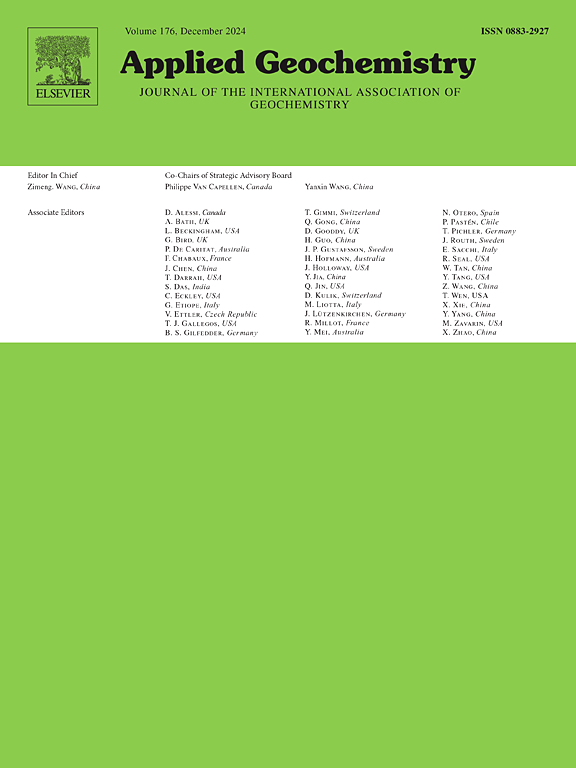阿巴拉契亚煤矿废弃物被动处理过程中析出的氧化锰的特征
IF 3.4
3区 地球科学
Q1 GEOCHEMISTRY & GEOPHYSICS
引用次数: 0
摘要
宾夕法尼亚州的煤矿排水区通常含有高浓度的锰,以及锌、镍、铝、钴和铁等污染物。由鹅卵石石灰石/白云岩床组成的被动处理系统已被用于促进锰氧化沉淀,这也可以通过掺入或吸附在氧化锰矿物上去除其他金属。在这里,我们研究了位于宾夕法尼亚州贝尔伍德附近格拉斯哥的白云岩衬里被动煤矿排水处理系统的锰氧化物沉淀和水地球化学。我们专注于以特殊的细节表征沉淀的锰氧化物相,以弥合我们对合成锰氧化物从实验室到现场的理解。采用x射线衍射、扫描电镜/能量色散x射线能谱、x射线光电子能谱、傅里叶变换红外能谱、透射电镜、x射线吸收精细结构分析和拉曼光谱等方法对锰氧化物进行了收集和分析。还收集了水样,并使用电感耦合等离子体光学发射光谱(ICP-OES)分析了pH和金属浓度。对鹅卵石表面涂层的分析显示,这些鹅卵石表面含有构造锰酸盐和层状锰酸盐的混合物,包括云母岩、三斜状和六角形硼钼矿/辉钼矿样结构。拉曼图显示,锰氧化物相在微米尺度上相互混合。在样品中观察到三斜晶和六方晶状birnite相组成的差异,三斜晶状birnite中Ca、Mg、Al、Co和Ni的含量高于六方晶状birnite。水分析表明,该处理系统在水渗入卵石白云岩床层时能有效去除Mn、Zn、Ni和Fe。本文章由计算机程序翻译,如有差异,请以英文原文为准。

Characterization of Mn oxides precipitated by passive treatment of Appalachian coal mine wastes
Coal mine drainage sites across Pennsylvania often contain high concentrations of Mn, along with contaminants such as Zn, Ni, Al, Co, and Fe. Passive treatment systems consisting of cobbled limestone/dolostone beds have been used to promote Mn oxidative precipitation, which can also remove other metals via incorporation into or adsorption onto the resulting Mn oxide minerals. Here, we examine Mn oxide precipitates and aqueous geochemistry of a dolostone-lined passive coal mine drainage treatment system in Glasgow near Bellwood, PA. We focus on characterizing the precipitated Mn oxide phases with exceptional detail to bridge our understanding of synthetic Mn oxides from the laboratory into the field. Mn oxides were collected and analyzed using X-ray diffraction, scanning electron microscopy/energy-dispersive X-ray spectroscopy, X-ray photoelectron spectroscopy, Fourier-transform infrared spectroscopy, transmission electron microscopy, X-ray absorption fine structure analysis, and Raman spectroscopy. Water samples were also collected and analyzed for pH and for metal concentrations using inductively coupled plasma-optical emission spectroscopy (ICP-OES). Analyses of the coatings on the cobbles revealed mixtures of tectomanganates and phyllomanganates, including todorokite and both triclinic and hexagonal birnessite/buserite-like structures. Raman mapping showed that Mn oxide phases are intermixed at the micron-scale. Differences in the compositions of triclinic and hexagonal birnessite-like phases were observed in the samples, with triclinic birnessites containing higher Ca, Mg, Al, Co, and Ni concentrations than hexagonal birnessites. Water analyses indicated that the treatment system was effective at removing Mn, Zn, Ni, and Fe as water infiltrated the beds of cobbled dolostone.
求助全文
通过发布文献求助,成功后即可免费获取论文全文。
去求助
来源期刊

Applied Geochemistry
地学-地球化学与地球物理
CiteScore
6.10
自引率
8.80%
发文量
272
审稿时长
65 days
期刊介绍:
Applied Geochemistry is an international journal devoted to publication of original research papers, rapid research communications and selected review papers in geochemistry and urban geochemistry which have some practical application to an aspect of human endeavour, such as the preservation of the environment, health, waste disposal and the search for resources. Papers on applications of inorganic, organic and isotope geochemistry and geochemical processes are therefore welcome provided they meet the main criterion. Spatial and temporal monitoring case studies are only of interest to our international readership if they present new ideas of broad application.
Topics covered include: (1) Environmental geochemistry (including natural and anthropogenic aspects, and protection and remediation strategies); (2) Hydrogeochemistry (surface and groundwater); (3) Medical (urban) geochemistry; (4) The search for energy resources (in particular unconventional oil and gas or emerging metal resources); (5) Energy exploitation (in particular geothermal energy and CCS); (6) Upgrading of energy and mineral resources where there is a direct geochemical application; and (7) Waste disposal, including nuclear waste disposal.
 求助内容:
求助内容: 应助结果提醒方式:
应助结果提醒方式:


